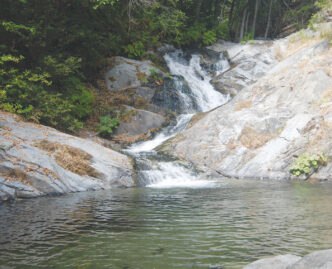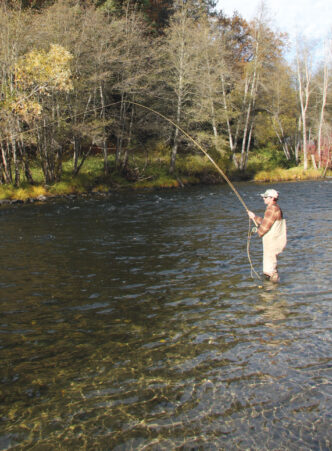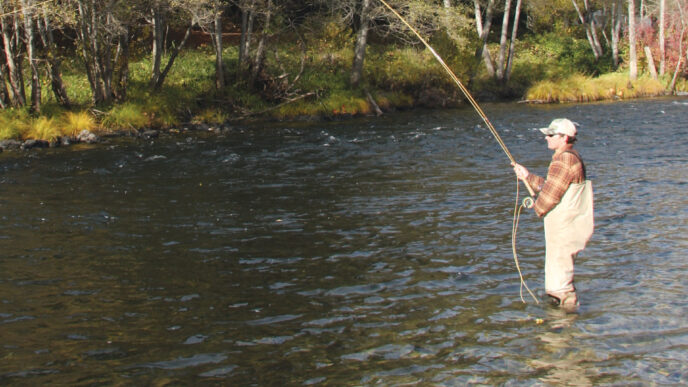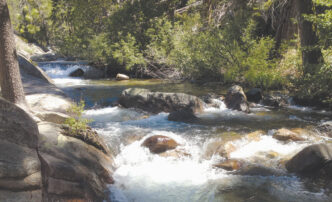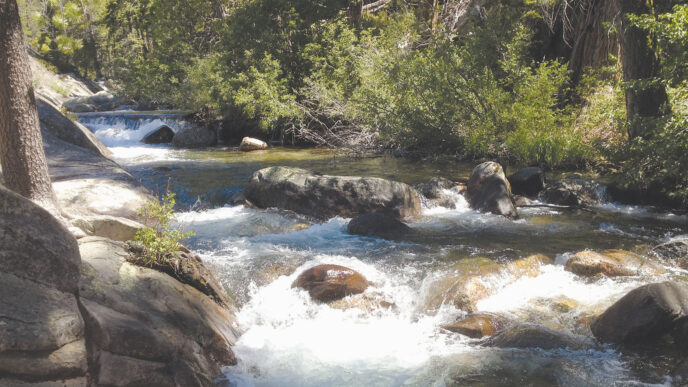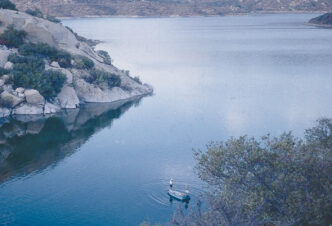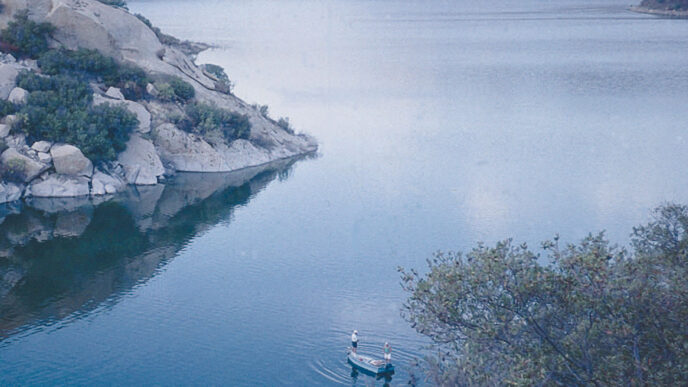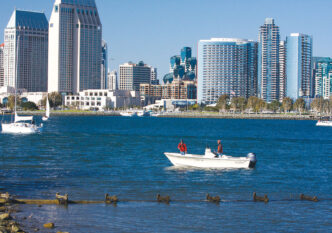In late fall last year, a friend and I drove over to the Whiskeytown National Recreation Area, eight miles west of Redding. Whiskeytown Lake, the centerpiece of this 42,500-acre area, which is focused on water-based recreation, is a by-product of the Central Valley Water Project, which seized Trinity River water and shunted it through and over the mountains and eventually to the San Joaquin Valley via the Sacramento River. Looking more like a natural lake than an artificial impoundment, Whiskeytown Lake offers superb boating, picnicking, swimming, and fishing, all within a beautiful, user-friendly setting.
The lake was not the destination this bright, crisp autumn day, but rather one of the creeks that flow into it. Within a bountiful watershed, several streams cascade down the sides of Shasta Bally and other surrounding mountains to feed the lake, including Boulder Creek, Brandy Creek, Mill Creek, and Crystal Creek. Another is Clear Creek, whose origin is in the Trinity Mountains to the northwest. Unlike small streams in places such as the Sierra Nevada that rely mainly on snowmelt for their water, Whiskeytown’s creeks are sustained by mountain springs and groundwater. Snowmelt from 6,199-foot Shasta Bally does bolster them in the spring, and their flows do shrink as the summer and fall months pass. Nevertheless, they run all year long, thanks to springs.
On this day, I wanted to reconfirm that each of these small waterways holds a plentiful supply of native rainbows. This was validated surprisingly quickly in Brandy Creek, one I had not fished before. Within 20 minutes of leaving our car, after an easy walk, with the fall foliage shimmering in yellows and oranges, primarily from bigleaf maples, my companion and I each hooked a sparkling rainbow in one of the runs cascading down through the forest. The fish were only about eight inches long, but they glimmered with deep colors and pronounced parr marks. To those of us who love this sport, trout like this are truly one of nature’s most beautiful gifts.
To me, the kind and quality of fish matter a great deal. The rainbows that occupy Whiskeytown’s creeks are probably as pure a native strain as is available these days, with their lineage going far back in time in the region that gave birth to this iconic species. The fly fisher who seeks out such creatures clearly has to be more interested in beauty and our natural heritage than in hooking, say, the larger, hatchery-reared specimens that are stocked in many of California’s lakes and streams or in targeting introduced species such as brook and brown trout.
Whiskeytown National Recreation Area is not a usual destination for the fly fisher. The lake itself is not highly rated for fly fishing, unlike close-by Shasta Lake. An entrance fee is charged (see sidebar). And the trout in the creeks are small — a 10-incher would be a trophy. But, if you are in good physical shape, an outing to one or more of Whiskeytown’s creeks offers multiple rewards, with casting or dapping a fly for beautiful rainbow trout being just one of them. The jewels in the diadem are the waterfalls on Whiskeytown’s creeks.
Water and Waterfalls
The natural environment in the Whiskeytown National Recreation Area is truly special. In places unaffected by early logging, the forests boast old-growth sugar pines, Douglas firs, ponderosa pines, incense cedars, black oaks, and canyon live oaks. The understory, particularly along the waterways, is replete with dogwood, whiteleaf manzanita, Western redbuds, varied fern species, St. John’s wort, ceanothus, wild iris, wild ginger, and wild grape, among many other plants. Mushroom seekers come here, as do rock hounds. One prevalent stone is Copley greenstone, which is a Devonian metamorphic rock of near-shore oceanic origin formed about 400 million years ago. It ranges in color from dull orange and light brown to dark blue-green. And with Whiskeytown’s hundreds of miles of trails, this is a favorite place for hikers, dog walkers, mountain bikers, and equestrians. Wildlife abounds, with bears, mountain lions, bobcats, rattlesnakes, giant banana slugs, and other species occupying the terrain.
But the magnificence of the water and the waterfalls sets Whiskeytown apart in my view. The water flowing down the mountainsides on Whiskeytown’s southern side is as sparkling clear as water could possibly be. There are no cow-occupied meadows, no impoundments or diversions to deny the creeks their full, cleansing rush downward. Any residues from logging or mining from the distant past have long been washed away. What remains is just the purest of water — bubbling, cascading, rippling, gushing, and tumbling over boulders and ledges as it seeks the lake. When one is alongside such purity, one cannot help but be refreshed in body, mind, and spirit. (Ironically, not too distant from the cleanest water in Shasta County is the most contaminated. Nearby sits Iron Mountain, site of the former Keswick Copper Mine and other mining operations, which produced one of the most toxic of all Superfund cleanup sites.)
The most spectacular of Whiskeytown’s water displays are waterfalls, the major ones being Brandy Creek Falls, Boulder Creek Falls, Crystal Creek Falls, and Whiskeytown Falls. These plummeting and cascading shows of water resemble icicles in motion and alone provide ample reason to come to Whiskeytown. The park even promotes this attraction with its Waterfall Week in April.
The fly fisher can easily combine a trek to a waterfall with fishing some of the better pools along the way and might often be the only one so engaged. Here is a brief rundown on each of Whiskeytown’s most notable waterfalls and the fishing that can be had on the creeks where they occur.
- Brandy Creek Falls. This waterfall has a drop of 50 feet in a unique split formation through steep vertical walls. It’s a moderate 1.75-mile hike from the trailhead on Brandy Creek Road, which is off Kennedy Memorial Drive. Lower Brandy Creek Falls is first reached after 1.5 miles, with the upper falls another 0.25 miles ahead. If one wishes to increase the length of the hike by 2.5 miles and experience more of Brandy Creek, a trailhead to the falls is located right on Kennedy Memorial Drive. (It is here that my friend and I parked last fall, as recounted at beginning of this article.) All told, from its inlet at Whiskeytown Lake to the upper falls, there are more than four miles of fishable water, all traversed by a trail, although it is sometimes high above the creek. The flows in Brandy are comparatively substantial.
- Boulder Creek Falls. The trailhead to this waterfall is reached from South Shore Drive, a dirt road accessed from either the end of Kennedy Memorial Drive or from the powerhouse at the north end of the lake. From the trailhead about midway on South Shore Drive, it is 2.75 uphill miles to the falls. These exceptionally pretty falls cascade down in three separate drops totaling 138 feet, all tucked into a dark, shaded box canyon filled with moss and ferns. The creek flows are modest, so pools holding fish are spread out.
- Crystal Creek Falls. The falls on the West Fork of Crystal Creek, which drains the western quadrant of Whiskeytown’s watershed, can be visited with a mere five-minute walk from a parking area at Crystal Creek Road at the far western end of the park. This is the same road to the highly popular Whiskeytown Falls (see below) and is so noted by a sign on Highway 299. Crystal Falls is another beautiful waterfall, encompassing a series of drops and cascades. Surprisingly, it is not natural, but was produced when the creek was diverted 50 feet to flow over a number of ledges as part of the Central Valley Project’s creation of Whiskeytown Lake and subsequent manipulations. After the falls, the creek plummets in a staircase of small plunge pools down a modest canyon. The water throughout is gloriously clear and sparkling, aptly befitting the name “Crystal.” This is a place for the hardy fly fisher to probe with a fly. One can also access Crystal Creek from a point down closer to Highway 299 and work upstream.
- Whiskeytown Falls. Except for loggers, hardly anyone knew of this waterfall until 1967, when a few park rangers first learned of its existence. But lacking funds to protect this hidden treasure from hippies and other interlopers, they kept it quiet. These rangers eventually moved on, taking their secret with them. It was not until 2004 that park biologist Russ Weatherbee, after hearing vague rumors of a large waterfall tucked away in a remote part of the park, saw a reference to falls while examining an old creased and frayed logging map stuck in a desk drawer. “Somebody had drawn a dot on one of Crystal Creek’s tributaries and labeled it a waterfall,” Weatherbee said. From topographical photos, he located its probable site where the creek dropped precipitously over a short distance. He made a couple of treks in the dense backcountry wilderness and steep granite canyons to try to find it. Eventually, he located it in an obscure box canyon. This “discovery” of a “new” spectacular waterfall made headlines across the globe, even in the Wall Street Journal.
Whiskeytown’s staff started building a trail, and upon its completion in 2006, the 3.5-mile James K. Carr Trail to what was designated “Whiskeytown Falls” became one of the park’s most popular hikes and remains so today. The falls cascade down a series of three granite platforms for 220 feet. As usual, the water throughout the long run of this creek — the East Fork of Crystal Creek — is sparkling, clear, and cold. On one of my many visits to it — a standard hike with visiting guests — I brought my fly rod and hooked a beautiful rainbow in the pool directly below the falls. On another outing specifically for fly fishing, I hooked a bunch of small rainbows in stretches of the creek farther down, where it tumbles in tight surroundings. Wherever I dapped a fly in holding water, there was a rainbow or two anxious to take it.
In addition to the four creeks with falls, the Whiskeytown National Recreation Area also offers the fly fisher other opportunities to fish for wild rainbows in beautiful surroundings. Two notable possibilities are Mill Creek and Clear Creek. - Mill Creek. A trail follows Mill Creek for 6.4 miles through a cool canyon with lots of vegetation, requiring several creek crossings, all the way to a summit. Mill Creek offers opportunities right alongside the trail to hook one of Whiskey-town’s native rainbows.
- Clear Creek. This is a much larger stream than those discussed above. It enters Whiskeytown Lake from the north. It enjoys a long run from its origins in the Trinity Mountains, flowing above, through, and below the town of French Gulch before crossing Highway 299 and eventually draining into the lake. (Before being separated in two parts by Whiskeytown Reservoir, Clear Creek was the longest creek in California, at approximately 61 miles in length.) Hatchery rainbows are planted in the creek at French Gulch. It also serves as a spawning waterway for kokanee salmon stocked in Whiskeytown Lake, where they attract scores of hardware and bait anglers.
However, native rainbows can be found in the higher reaches of Clear Creek past French Gulch. Much of the land alongside the creek is private, so access is limited. If you continue driving up Trinity Road past the last structures, the creek below in the canyon provides opportunities for the adventuresome fly fisher.
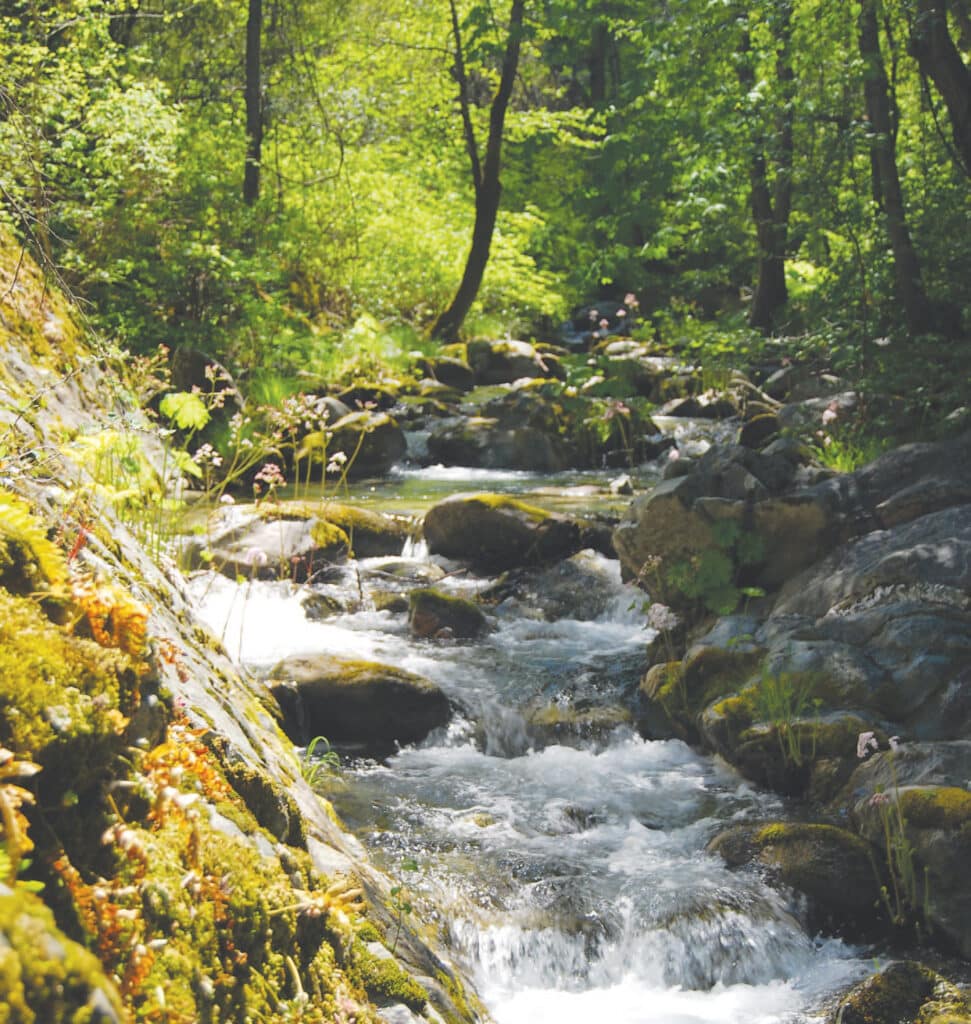
Fly Fishing Whiskeytown’s Creeks
The fish in Whiskeytown’s creeks run small, but when I am fishing there, I could not be more engaged. It’s as though all of the elements of fly fishing are miniaturized, as well, and condensed, intensified — the stream, the canyon, the foliage, the trout. The experience of hooking a delicate native rainbow, bringing it to shore, absorbing its beauty, and then gently releasing it back to this resplendent water captures the essence of why I fish.
These creeks are small as fly-fishing waters go, and they get smaller as the summer and fall progress. More than usual, the fly fisher has to find that piece of holding water that trout need to feed and survive. This may take some searching as one wends through the small ravines and canyons where these creeks run.
I typically use a dry-fly pattern that is clearly visible on the surface, without regard to what it resembles — for example, a Parachute Adams. In such pristine water with few insect hatches, trout have to feed opportunistically. I toss the fly where the current can take it or let it sit in a swoosh of water, and if nothing happens, I make the fly dance or act as if it is alive, as in a retrieve. This usually causes a fish in the vicinity to strike it. Many times, the hit is quick without a hookup, because the trout’s instinct is to nip the retreating fly, rather than engulf it. Although these rainbows are small, they therefore can still be a challenge to hook. Sometimes the fish are hungry, though, and hookups are frequent. Although I have not tried this approach, fishing near where a stream enters Whiskeytown Lake might result in hooking a larger fish coming in from the lake. Whiskeytown’s creeks can be fished throughout the standard season. The best time to see the waterfalls is the spring, when flows are highest and pools and runs the largest. The dead of summer is hot there, so early mornings or evenings would be the most comfortable times to hike and fish, particularly given the effort needed to cover lots of water. Autumn offers idyllic conditions. Yes, the flows are considerably lower, but easier streamside trekking in the brisk air allows one to locate those pools that surely hold the biggest fish in the creek.
A fly fisher can easily spend one full day fishing one of these creeks, possibly with a visit to its waterfall. Experiencing them all in this manner can take the better part of a week. The more energetic can sample two or even three of the creeks in one day. It just depends on what one is seeking in visiting these special waters.
If You Go…
A trip to Whiskeytown’s Creeks should begin with a stop at the visitors center at the eastern entrance to the Whiskeytown National Recreation Area.
Brochures and maps containing all of the information needed to locate trails, calculate distances, and so on can be picked up there, and rangers and volunteers are available at the center to answer questions, although I’ve found no one at the park who knows much about fishing the creeks. The National Park Service charges are $5 for day use, $10 for a week, or $25 for the season. If you have an America the Beautiful Interagency Pass, successor to the Golden Eagle and other such passes to national parks, it applies at Whiskeytown, as well. Just display it on the dashboard.
A fishing license is required. Angling in the streams is confined to the regular season. As usual, check the regulations to be sure you’re legal.
Whiskeytown has several campgrounds for trailers or tent camping for those who wish to remain close to the scene and soak up the atmosphere of this area. There is a bed-and-breakfast and a good restaurant in nearby French Gulch. Redding presents a full complement of lodging and dining choices.
Whiskeytown Lake itself is a wonderful resource to use during a visit. The water offers a refreshing swim, and kayaking is a delightful way to explore parts of the lake. One might even troll a fly and see what it can catch.
Bob Madgic



